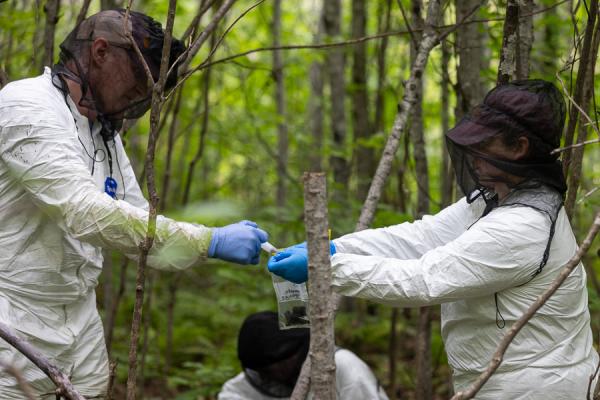Envisioning a future without brain tumors
March 11, 2024

Susan Arnold’s fourth year of vet school was marked by extremes of joy and tragedy, and those divergent emotional paths ended up leading her down a singular career path—to the Canine Brain Tumor Program at the University of Minnesota.
The joy she experienced that year was in discovering her passion for neurology. Approaching the end of her program in veterinary medicine at the University of Wisconsin, she’d been feeling real doubt about her long-held goal of becoming a wildlife epidemiologist. “It was so hard, but I had a bit of a heart to heart with myself and realized it wasn’t really what I wanted anymore,” she described.
Then, she started a new rotation in the neurology department. Rotations are designed to give advanced students clinical experiences across a range of specialties and practices. Arnold walked into the busy neurology department on her first day hoping mostly that she wouldn’t get in the way. Very quickly, a young standard poodle named Batman who had been hit by a car was transferred to their care. He had an injury to his brachial plexus—the network of nerves in the armpit that carries movement and sensory signals to the front legs. It’s a common result of such a car accident, and it can lead to permanent paralysis.
Arnold was responsible for Batman during his time in the hospital, and it was thrilling to watch him recover. Her experience in that rotation gave her a new sense of purpose and direction.
Around the same time, she received heartbreaking news: one of her high school friends, Curtis, had been diagnosed with glioblastoma, an aggressive and deadly form of brain cancer.
“He was the most popular guy in high school for all the right reasons,” Arnold described. “He was nice to everyone, and everyone loved him in return.” Curtis had woken up one morning suddenly unable to see, and he quickly received the devastating diagnosis. He passed away 18 months later.
The juxtaposition of these life experiences—her discovery of her love of neurology and her experience of losing a friend to glioblastoma, was pivotal: she decided to shift her career path toward neurology and neurosurgery, with a heavy emphasis on brain tumor research.
As luck would have it, an internship brought Arnold to the University of Minnesota College of Veterinary Medicine (CVM), where Liz Pluhar was Director of the Canine Brain Tumor Program. That program, housed at the Masonic Cancer Center, coordinates collaborations between medical researchers and veterinarians to diagnose brain tumors in dogs and treat them with breakthrough therapies.
As Arnold described the work of the Program, “There are very few options for treating brain tumors in dogs, so the research is crucial for helping dogs and their families. And we’ve also learned that dogs are an excellent model for brain tumors in people, so we can take the knowledge we gain and see if it can be applied in human medicine.” Pluhar and the Canine Brain Tumor Program were trailblazers in this area of comparative medicine.
They welcomed Arnold enthusiastically. “Liz went out of her way to offer me learning experiences. I was scrubbing into craniotomies from the very beginning,” she described. As time went on, Pluhar and Arnold discussed the possibility of a permanent home for Arnold at CVM and with the Brain Tumor Program. And so after a residency at the University of Georgia, she returned to CVM as a faculty member in 2019. Her role is a dual one, split between work as a clinical neurologist at CVM’s Veterinary Medical Center, and a researcher in the Brain Tumor Program.
Arnold has joined in the Program’s work developing effective immunotherapies—therapies that use the body’s own immune system response to help fight tumor cells—through a clinical trial for dogs diagnosed with glioma (the umbrella term for brain tumors that include glioblastoma). Going forward, one major interest she has is incorporating radiation therapy into treatment protocols alongside immunotherapy. “We know these tumors respond well to radiation therapy. The median survival time for dogs with gliomas is about 500 days with radiation therapy. That’s a little better than the average 14 months in people,” she described. “The question is, can we get them to respond even better by combining radiation with other experimental therapies? And what might this mean for human medicine?”
Along with being a full-time faculty member and researcher, Arnold is also finishing her PhD at CVM in comparative and molecular biosciences. Her PhD work involves research into treatment response for brain tumors in relation to genetic differences among dog breeds—in particular, French bulldogs, which are highly prone to brain tumors and have demonstrated poor responses to treatment compared to other breeds. This work, too, has translational potential for human brain tumor sufferers, as it could provide clues to the genetic basis of why some people respond to treatment and others don’t.
Reflecting on the exciting collaborations she’s developing to enable her research, Arnold noted, “I can say confidently that there is no place as strong as the U of M for collaborative translational brain tumor research. We are one of the very few veterinary medical schools in a major metro area that’s home to so many healthcare companies, and is on the same campus as human medical school, a cancer center, and many other excellent research departments. When I think about doing this work elsewhere—it’s possible, but it wouldn’t be nearly as efficient or expansive as it can be here.”
That efficiency and expansiveness will be crucial for Arnold to achieve her ambitious long term-goals, as she recognizes: “Fifty years from now, I want us to be able to say, ‘Do you remember when glioblastoma was a terminal disease?’ It might sound naive, since so many people have tried to tackle this problem before us. But that’s what we’re all working for. That’s what we strive for.”


